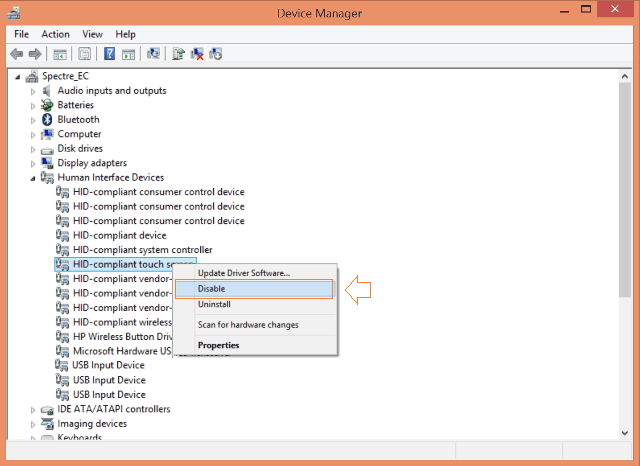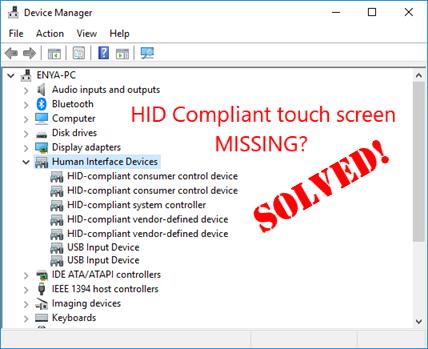‘Of all the things I’ve lost
I miss my mind the most’
Ozzy Osbourne
We need hardly tell you that touch screen issues are extremely dispiriting and that they always occur at the worst possible time. However, if your HID-compliant touch screen is missing, there is no need to despair: we know how to fix compliant touch screen not showing in Windows 7, 8, and 10. Just follow the instructions below to resolve your problem:
Show hidden devices
Hid Compliant Touch Screen Driver free download - Driver Booster, Bluetooth Driver Ver.5.0.1.1500.zip, Screen Recorder, and many more programs.
- DRIVERS TOSHIBA TOUCH SCREEN LAPTOP FOR WINDOWS 10 DOWNLOAD. Toshiba satellite laptop. Touch screen laptop. Touch screen ultrabooks, toshiba screen mirroring, hyperthreaded intel core, connecting ac adaptor always, toshiba satellite p55t. How to print screen on a toshiba laptop, 8 steps. Hard drive mercury silver. Customer satisfaction priority toshiba, pen touch input.
- 4: Uninstall and Drivers you Installed Check Start Settings Apps and verify that drivers weren't installed for your Touch Screen. As we've been discussing, you should let Windows Updates install your driver. If there's a touch screen driver found, uninstall and reboot. Similar: How to Download the Latest Drivers for Windows.
First and foremost, let’s make sure your HID-compliant touch screen is not hidden. Here is what you should do to unveil your hidden devices:
- Invoke the Run app: for this, simultaneously press the Windows logo key and the R letter key on your keyboard.
- Into the Run search bar, type in the following: devmgmt.msc.
- Now press Enter or click OK to proceed.
- Once you are in Device Manager, navigate to the View tab and click on it.
- From the drop-down menu, select the Show hidden devices option.
- Then proceed to the Action tab and click the Scan for hardware changes option.
Finally, you should move to Human Interface Devices, expand it, and check if you can see your HID-compliant touch screen in this section now.
Make use of Hardware and Devices Troubleshooter
Microsoft’s Hardware and Devices Troubleshooter may prove the most efficient means of getting your HID-compliant touch screen back on track, so it is a wise idea to call upon the tool in question and let it do its job.
Here is how to use Hardware and Devices Troubleshooter in Windows 10:
- Press the Windows logo key and the S key simultaneously to run the Search app.
- Into the Search bar, input ‘troubleshoot’ (without quotes) and press Enter to proceed.
- From the list of results, select the Troubleshoot option.
- In the right-pane menu, select Hardware and Devices.
- Move down to the Run the troubleshooter button and click it.
- Click Next to continue.
- Follow the instructions you see on the screen.
And that is what you should do to utilize Hardware and Devices Troubleshooter in Windows 8 or 7:
- Open your Start menu, locate the Search bar and type “troubleshoot” (no quotes).
- Press Enter to proceed.
- Select Troubleshooting from the list of search results.
- Move down to Hardware and Sound.
- Click Configure a device.
- Click Next to proceed with your Troubleshooting.
When you see the on-screen instructions, do as you are told to ensure that no stone is left unturned in your quest.
When the troubleshooting process is over, open Device Manager and see if your HID-compliant touch screen is back.
Update your HID-Compliant Touch Screen driver
We never cease to repeat that keeping one’s drivers up to date is a must. Otherwise, your system cannot work the way it is supposed to. That is why it is time to check if you are using an updated HID-compliant touch screen driver – the thing is, your headache might stem from the driver in view being antiquated or missing.
There is absolutely no need to take a long hard look at all the options available: actually, in a scenario like yours, you can either search for the driver software you need yourself or recruit a dedicated piece of software to get things done. Let’s examine both these methods in more detail in order to make the best possible choice.
Frankly, updating your driver manually is of dubious benefit to you. Although there is a chance you can find what you need, the process is ridiculously time-consuming. On top of that, you may end up downloading and installing the wrong driver, thus putting your system in harm’s way. As such, we are convinced the game is not worth the candle. However, if you wish to utilize this method, you are free to do so. Just make sure you know exactly what you are looking for and where to find it.

The second option implies automating the process with the help of a special tool. We are sure this is the easiest as well as the safest way to set things right. These days such products are widely available on the market. For instance, you can opt for Auslogics Driver Updater: this program is equipped to do the job of fixing your drivers efficiently and accurately, and there is even more to it – you can have all your drivers updated at one go.
Resolve PC Issues with Driver Updater
Unstable PC performance is often caused by outdated or corrupt drivers. Auslogics Driver Updater diagnoses driver issues and lets you update old drivers all at once or one at a time to get your PC running smoother
After updating your HID-compliant touch screen driver, check if your problem has gone.
No Hid Compliant Touch Screen
We hope our tips have proved useful in fixing your HID-compliant touch screen. If you need extra assistance in resolving your problem or have any suggestions regarding the issue, you are welcome to state that in the comment section below. We are always here to help you!
If you check Device Manager only to find HID Compliant touch screen no longer there, you’re not alone.
But don’t worry, check out the fixes below and you’ll get it back in no time. 🙂
3 Fixes for HID Compliant Touch Screen Missing
Fix 1: Show hidden devices
There’s a good chance that you’ve accidentally hidden your HIP Compliant touch screen, hence the HIP Compliant touch screen not showing problem. If that’s the case, you should un-hide it. Here’s how:
1) On your keyboard, press the Windows logo key and R at the same time, then type devmgmt.msc into the box and press Enter.
2) Click View and then click Show hidden devices.
3) Click Action > Scan for hardware changes.
4) Check if your HIP Compliant touch screen shows up under Human Interface Devices now. If yes, then great! But if it’s no joy, you should move on to Fix 2, below.
Fix 2: Update your HID-complaint touch screen driver
Hid Compliant Touch Screen Driver Download Toshiba Chromebook
This problem may occur if you are using the wrong HID-compliant driver or it’s out of date. So you should update your HID-compliant driver driver to see if it fixes your problem.
If you don’t have the time, patience or skills to update the driver manually, you can do it automatically with Driver Easy.
Driver Easy will automatically recognize your system and find the correct drivers for it. You don’t need to know exactly what system your computer is running, you don’t need to risk downloading and installing the wrong driver, and you don’t need to worry about making a mistake when installing. Driver Easy takes care of it all.
You can update your drivers automatically with either the Free or the Pro version of Driver Easy. But with the Pro version it takes just 2 clicks (and you get full support and a 30-day money back guarantee):
1) Download and install Driver Easy.

2) Run Driver Easy and click the Scan Now button. Driver Easy will then scan your computer and detect any problem drivers.
3) Click Update All to automatically download and install the correct version of ALL the drivers that are missing or out of date on your system (this requires the Pro version – you’ll be prompted to upgrade when you click Update All).
4) Restart your computer and check if you got it back on your Device Manager. If yes, then congrats! But if the issue persists, please move on to Fix 3, below.
Fix 3: Run Hardware and devices Troubleshooter
Another trick we can try to fix your HID Compliant Touch Screen missing problem is to run Hardware and devices Troubleshooter, a built-in Windows tool designated to fix possible errors that might have been culprit for the issue.
Here’s how:
I’m using Windows 10:
- On your keyboard, pressthe Windows logo key and typetroubleshoot, then clickTroubleshoot.
- Locate and click on Hardware and Devices and click Run the troubleshooter.
- Click Next and follow the on-screen instructions to fix the issues it detects.
- Open Device Manager and check if the missing driver shows up.
I’m using Windows 8.1/7:
- On your keyboard, pressthe Windows logo key and typetroubleshoot, then clickTroubleshooting.
- Click Configure a device.
- Click Next and follow the on-screen instructions to fix the issues it detects.
- Open Device Manager and check if the missing driver shows up.
There you go – top 3 fixes for your HID-compliant touch screen missing problem. Hope this helps and feel free to drop us a comment if you have any further questions.